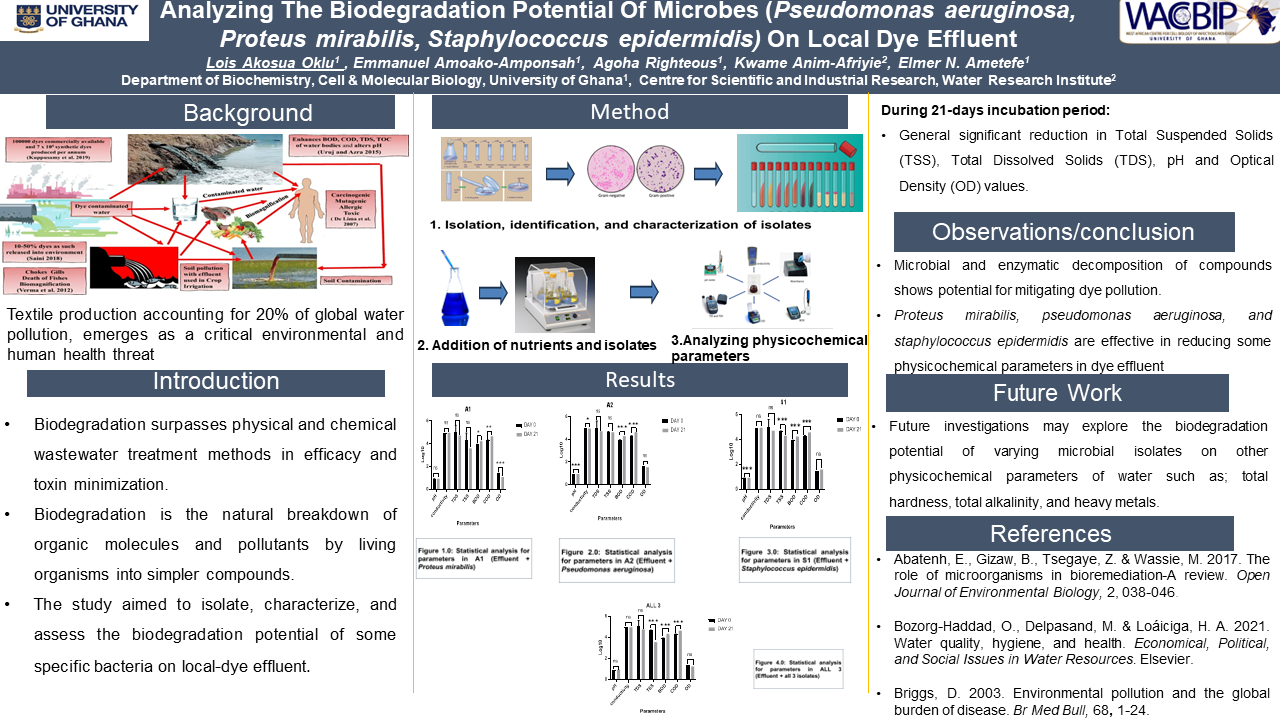Lois Oklu
Conference 2024 Poster
Poster Title
Analyzing the biodegradation potential of microbes (Pseudomonas aeruginosa, Proteus mirabilis, Staphylococcus epidermidis) on local dye effluent
Authors and Affiliations
Lois A. Oklu1, Emmanuel Amoako-Amponsah1, Agoha K. Righteous1, Kwame Anim-Afriyie2, Elmer N. Ametefe1
1.Department of Biochemistry, Cell and Molecular Biology, University of Ghana, Accra, Ghana
2. Centre for Scientific and Industrial Research, Water Research Institute, Accra, Ghana
Abstract
Background
BACKGROUND: Water pollution particularly from textile effluent, is a significant global concern due to its adverse impact on the environment and human health. Local-dye effluents, which contain various harmful compounds including synthetic dyes and potentially toxic metals like; Chromium, zinc, iron, mercury, and lead, are released directly into water bodies without any form of treatment, hence posing a threat. The hypothesis suggests that, specific microorganisms (bacteria and fungi) release enzymes such as oxidases, and hydrolases to break down pollutants (a biodegradation process), offering a cost-effective and safe approach to mitigating water pollution caused by textile effluents.
Methods
METHODS: Local dye effluent samples were collected and the indigenous bacteria were isolated, characterized and identified using Gram-staining and biochemical tests techniques. The biodegradation effect on physicochemical parameters: Biological Oxygen Demand (BOD), Chemical Oxygen Demand (COD), Total Dissolved Solids (TDS), Total Suspended Solids (TSS), pH, temperature, conductivity, and Optical Density (OD), were analyzed before and after the treatment process using their specific instruments and processes over a period of 21 days. Statistical analysis of obtained data was analyzed using multiple paired t-test analysis.
Results
RESULTS: Bacteria isolates obtained included; pseudomonas aeruginosa, proteus mirabilis, staphylococcus epidermidis, staphylococcus saprophyticus, listeria sp, and Corynebacterium sp. Following biodegradation, the effluent samples treated with proteus isolate and a mixture of isolates (proteus, pseudomonas, and staphylococcus sp.) resulted in a clearer and less cloudy effluent. A decrease in initial values for physicochemical parameters were recorded to be statistically significant based on P-values obtained from multiple paired t-test analysis above the WHO limit, and this indicated a positive degradation process.
Conclusions
CONCLUSIONS: The results of the study conducted indicated that Pseudomonas aeruginosa, Proteus mirabilis, and Staphylococcus epidermidis has appreciable potential for treating local dye effluent as they showed positive results in reducing some physicochemical parameters in dye effluent (conductivity, TSS, TDS, colour, and OD) and hence, can be used for the treatment of local dye effluent contaminated waters.


Leave A Comment